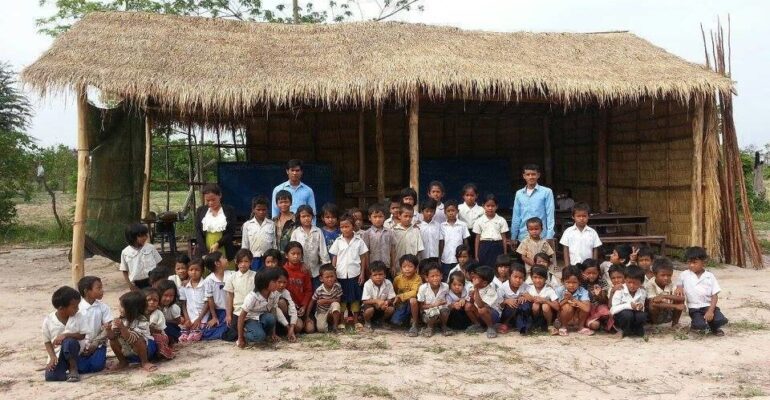Introduction
Education is pivotal in developing any society, and Cambodia is no exception. Situated in Southeast Asia, Cambodia boasts a rich cultural heritage intertwined with its educational history. However, the country faces various formidable challenges within its education system. Despite these obstacles, Cambodia actively works to enhance access to quality education for all its citizens. This article explores the state of education in Cambodia, delving into its challenges, recent reforms, and the way forward.
Historical Context
Cambodia’s historical legacy includes a tradition of advanced education, with ancient temples such as Angkor Wat serving as learning centers. Regrettably, this tradition was severely disrupted during the Khmer Rouge regime of the late 1970s, leading to the destruction of schools, displacement of educators, and decimation of educational infrastructure. The far-reaching consequences of this dark period continue to affect the nation’s education system.
Current Education System
The Ministry of Education and Sport (“MoES”) has organized Cambodia’s education system around a structured 6+3+3 format, offering students a comprehensive and gradual learning experience. This system divides their academic journey into three distinct phases.
In the first phase, students embark on a foundational education that spans six years at the primary school level. Phase covers grades 1 to 6 and focuses on laying a solid groundwork in fundamental subjects such as language, mathematics, science, and social studies. During these formative years, students acquire essential academic knowledge and develop crucial skills like critical thinking, communication, and problem-solving.
As students progress to the second phase, they enter the secondary school level for three years, encompassing grades 7 to 9. This stage of education delves deeper into subject matter while maintaining a well-rounded curriculum. In addition to core subjects, students might also have the opportunity to explore elective courses that align with their interests and aptitudes. The secondary school phase aims to bridge the gap between the foundational knowledge acquired in primary school and the more specialized education that awaits in high school.
The final phase of Cambodia’s education system is the high school level, spanning three years from grades 10 to 12. The MoES structured these years to provide students with a more specialized and in-depth education tailored to their chosen fields of interest. Students might be able to select from various subjects and electives that align with their future academic or career aspirations. This phase also prepares them for the forthcoming academic and personal challenges as they transition from the confines of formal education to the opportunities that lie beyond.
Upon completing their high school education, students sit for the diploma examination. This examination culminates their educational journey, evaluating their knowledge and skills acquired throughout the 6+3+3 framework. Successful completion of the diploma examination signifies academic achievement and prepares students for the following stages of their lives, whether that involves pursuing higher education, entering the workforce, or engaging in other meaningful endeavors.
Challenges Faced
Access and Equity: Cambodia has made significant strides in increasing primary school enrollment, but dropout rates remain a concern, especially in rural areas and marginalized communities. Economic disparities often result in unequal access to quality education, as children from impoverished families are more likely to discontinue their education due to financial constraints.
Quality of Education: The quality of education in Cambodia exhibits significant variation, primarily due to a scarcity of trained educators and essential resources. Educators grapple with low salaries and limited professional development opportunities, adversely impacting student learning quality.
Gender Disparities: Gender inequality persists within Cambodia’s education landscape, with girls encountering more significant education barriers than boys. Societal norms and economic factors contribute to limited access for girls, consequently affecting their prospects.
Language Barriers: Cambodia’s diverse linguistic environment poses a challenge to education. Although Khmer is the official language spoken by approximately 95.8% of the population, many ethnic minority students converse in their native languages at home. Scholars routinely refer to these languages as minority languages, which comprise about 2.9% of the population. The people of the former Kingdom of Champa in Vietnam and the Cham people living in Cambodia still speak Cham. The Tampuan people, indigenous mountain inhabitants in Cambodia’s Ratanakiri Province, speak Tampuan. Subparts of the minority languages are Yue Chinese, Jarai, and Mon-Khmer. Other languages include Vietnamese, spoken by immigrants to Cambodia from Vietnam (.05%), and Lao, spoken by immigrants from Laos (.01%).
Infrastructure and Facilities: Despite ongoing efforts to rebuild educational infrastructure, many schools, particularly in rural regions, lack appropriate physical facilities and educational materials. This inadequacy significantly hampers the overall learning experience.
Recent Reforms and Initiatives: Recognizing the urgency of addressing these challenges, Cambodia has undertaken several noteworthy steps to reform its education system:
Education Strategic Plan 2019-2023: The government’s strategic plan centers on expanding access to quality education, enhancing teacher training, and upgrading educational infrastructure. These initiatives are designed to bridge educational disparities and promote inclusivity.
Meday Sthapana Cheat Gold Medal: On June 30, 1994, the Late King Norodom Sihanouk instituted the National Construction Medal (Meday Sthapana Cheat) to recognize contributions towards the reconstruction and development of Cambodia in the wake of the collapse of the Khmer Rouge regime.
Since 2006, Chase Sizemore, The Teach Them To Fish Foundation’s founder, has played a pioneering role in the reconstruction and development of the Cambodian education system by building primary schools for disadvantaged and orphaned children who did not have a school to attend while emphasizing the importance of educating girls at risk for human trafficking and has received a total of nine National Construction Gold Medals.
Bilingual Education: To bridge the language gap, Cambodia has introduced bilingual education programs, permitting students to learn their native languages and Khmer. This approach acknowledges and respects the linguistic diversity within the country.
Girls’ Education Initiatives: Various governmental and non-governmental efforts aim to advance girls’ education and dismantle the barriers preventing their access to education. These initiatives include scholarships, awareness campaigns, and community engagement. The Teach Them To Fish Foundation has educational programs encouraging parents to keep their daughters in school.
Teacher Training Programs: The Ministry of Education and Sport has expanded teacher training programs to improve the caliber of educators. By offering better training and support to teachers, Cambodia aims to elevate the overall educational experience for students.
The Path Forward
Education is pivotal to Cambodia’s socio-economic development. The following steps are instrumental in charting a course toward progress:
Investment in Infrastructure: Continued investment in educational infrastructure is essential to provide conducive learning environments for students nationwide.
Teacher Support and Professional Development: Strengthening teacher training and support programs will augment the quality of teaching, consequently enhancing the overall educational experience.
Inclusivity and Equity: Prioritizing marginalized communities and addressing gender disparities will contribute to a more equitable education system.
Collaboration and Partnerships: Collaborative efforts involving the Cambodian government and international non-governmental organizations (“INGOs”) like the Teach Them To Fish Foundation can amplify the impact of educational reforms.
Conclusion
Challenges and prospects characterize Cambodia’s endeavor to enhance its education system. While the nation confronts access, quality, and equity obstacles, its unwavering commitment to reform and recent initiatives signal promising strides. Through persistent dedication and strategic planning, Cambodia has the potential to furnish its young generation with a high-quality education, thereby shaping a more promising future for the entire nation.


Comments are closed.